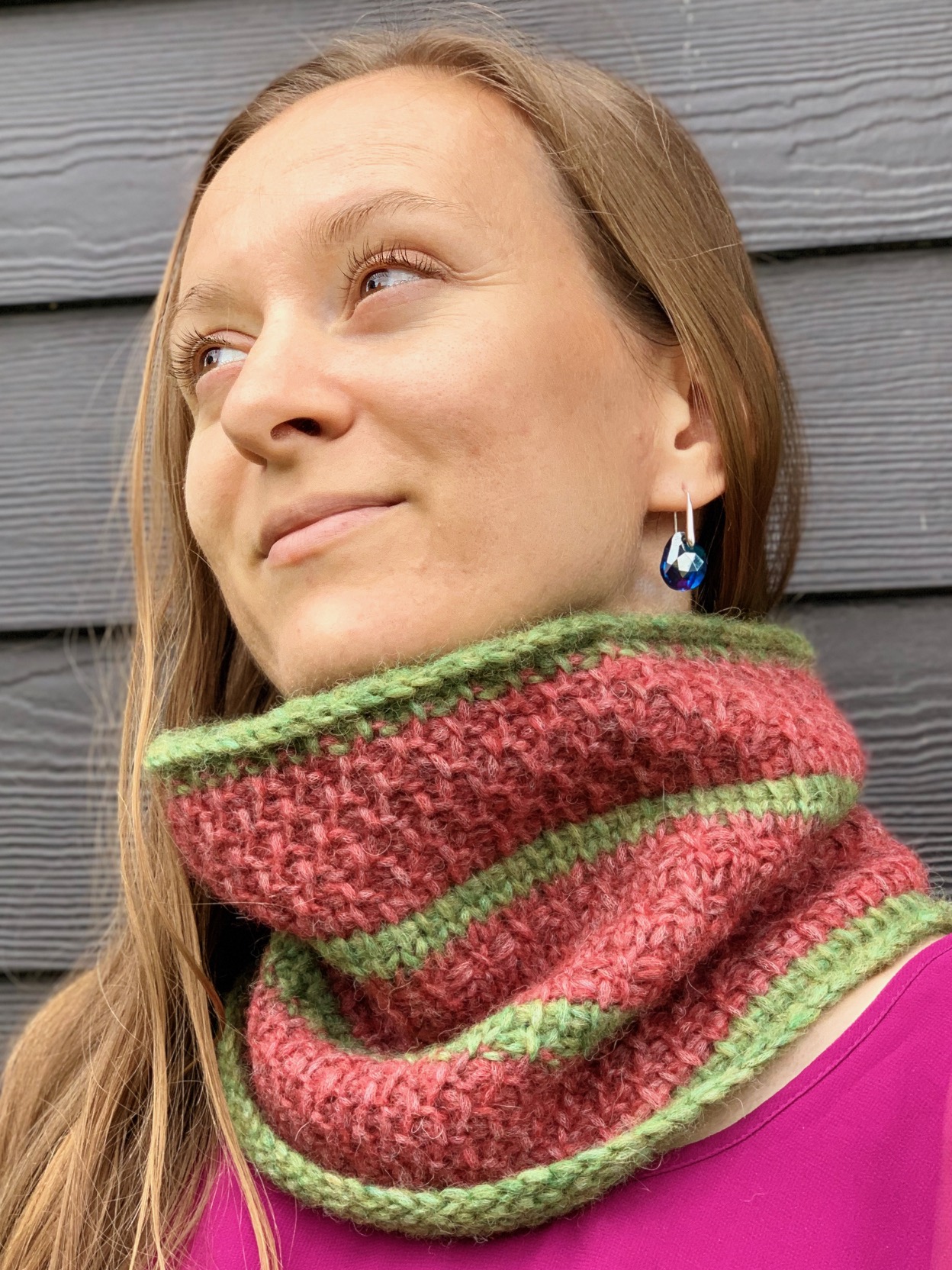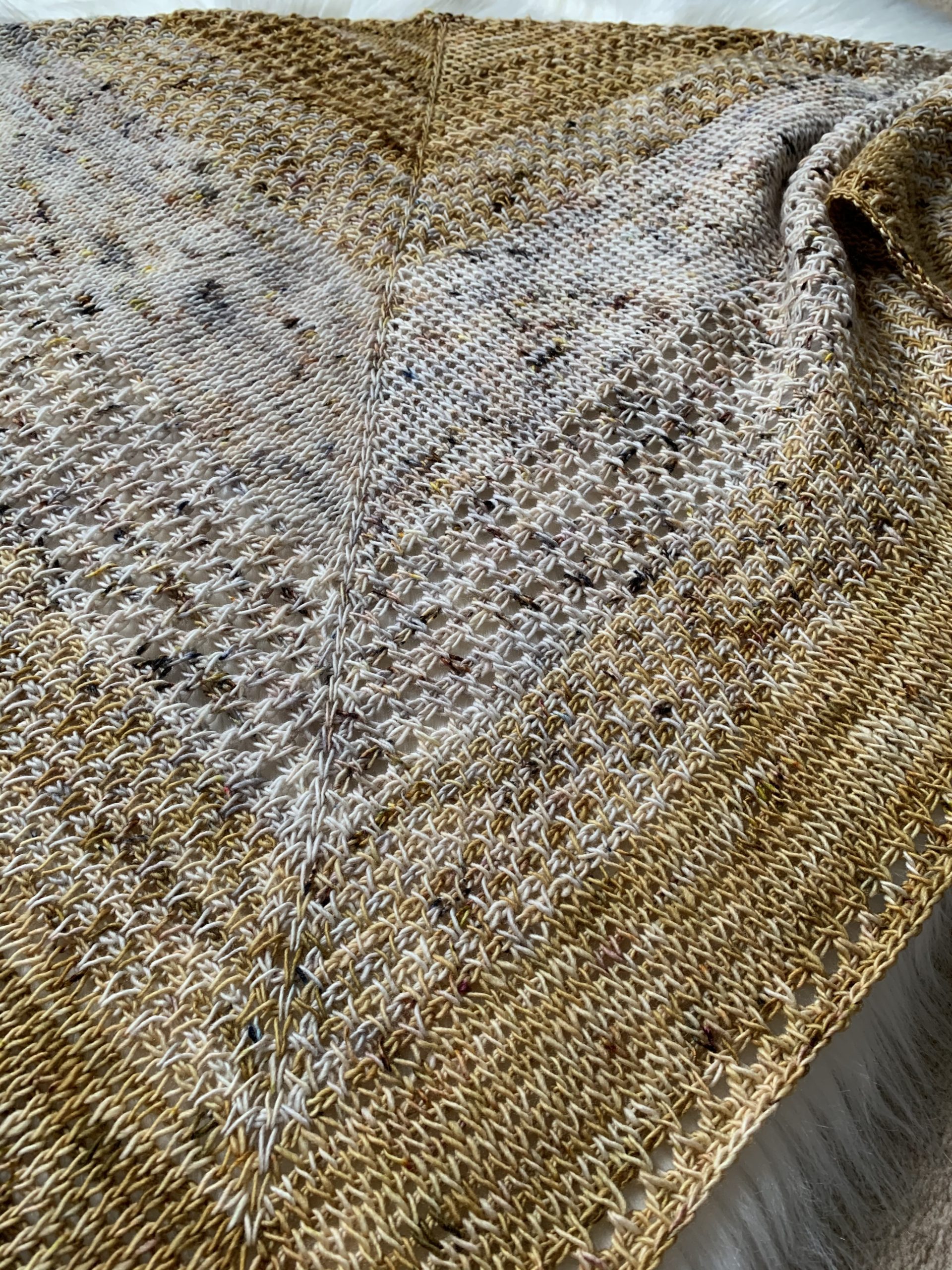This crochet cowl is made using Tunisian crochet technique; it is the perfect project for beginners as it enables you to learn the basics of Tunisian crochet including colour change, the Honeycomb stitch, how to start and bind off your project.
As the nights are getting longer and temperatures are plummeting, I am inevitably coming to terms with the fact that summer is gone once again. With a bit of nostalgia I am reminiscing on those long warm days spent out and about with my two little ones, we had so much fun! We played in our local park, ate moderate amount of ice cream and lots and lots of watermelon!
I had a design idea at the beginning of summer that came to fruition not long after and voila! The Watermelon cowl is here. Actually my lovely friends from Instagram suggested the name as the cowl was made in red and green yarn originally. It is made of wonderfully soft Alpaca blend that is hard to put down once you start crocheting with it!
You can purchase the add free PDF version of the pattern at LoveCraft here or Ravelry here.
This site contains affiliate links to products. We may receive a commission for purchases made through these links at no extra cost to you. This helps to cover the running cost of the website and enables me to continue making free patterns.
Please NOTE that this pattern is subject to copyright and is my intellectual property. The online version is for personal use only. Do not re-publish or sell this pattern in part or full, or make video tutorials of it. Any such actions are a breach of copyright and can result in legal action.

Skills required
To create this beautiful Tunisian crochet cowl you will need to master (or already know) these stitches and techniques:
Chain, Tunisian crochet technique (alternating forward and backward passes), Tunisian simple stitch (tss), Tunisian purl stitch (tss), Tunisian knit stitch (tks), Tunisian crossed stitch (tcs), end row changing colours, binding off in Tunisian crochet, blocking, Locking mattress stitch
Skill level

Sizes
The crochet cowl is available is several sizes:
Small (fits a small child) (S), Medium (M), Large (L)
Finished measurements
The final crochet cowl measurements (blocked):
S: 51 x 22 cm (approx. 20 x 8.75 in), M: 56.5 x 22 cm (approx. 22.25 x 8.75 in), L: 70 x 22 cm (approx. 27.5 x 8.75 in )
Materials and tools
To get the exact look as on the pictures of my Tunisian crochet cowl, you will need:
Drops Air (65% Alpaca, 28% Polyamide, 7% Wool | 10 ply, aran, worsted | 50 g (1.8 oz) = 150 m (164 yds)), Moss Green (A) #12 (S, M, L), Red Brick (B) #28 (S, M), Navy Blue (C) #9 (L)

Small size: approx. 42 g (28.5 g of Moss Green, 13.5 g of Red Brick); 1 ball of Moss Green, 1 ball of Red Brick
Medium size: approx. 48 g (32.5 g of Red Brick, 15.5 g of Moss Green); 1 ball of Red Brick, 1 ball of Moss Green
Large size: approx. 57 g (40 g of Navy Blue, 17g of Moss Green); 1 ball of Navy Blue, 1 ball of Moss Green
Tunisian crochet hook size 6 mm (J-10) with cable (at least 40 cm (16 in)) or size to obtain the gauge
Tapestry needle
Scissors
You can get your craft supplies here.
Gauge
Blocked Gauge:
14 sts x 14 rows = 10 x 10 cm (4 x 4″)
Gauge helps you to understand how the project turns out in terms of the final size. If you would like to achieve the exact size of the final project as in the instructions above, you gauge needs to match exactly to the above.
If you get more stitches and/or rows than stated above using the exact hook size as per instructions, your final project will turn out smaller. Conversely, if you get less stitches and/or rows than stated above using the exact hooks size as per instructions, your final project will turn out bigger.
To make adjustments, if you get more stitches and/or rows, you can try using bigger hook size to get closer to the desired size. Conversely, if you get less stitches and/or rows, you can try using smaller hook size to get closer to the desired size.
It may take trial and error to try out a few hook sizes to achieve the exact size.
Alternatively, if you really don’t want to make several samples to achieve the desired size, you can try to alter your tension as you work the project. However, I would advise to try this out once you master the basics of Tunisian crochet as it may be a bit tiresome to try to master the basics of Tunisian crochet and focus on alternating your tension while working the project.

Stitch guide
Tunisian crochet stitches are worked in forward and return pass from right to left, with the number of stitches (loops) increasing on the hook during the forward pass and decreasing during the return pass.
Return pass is worked in the same way for all stitches used in this project as follows: 1 ch, *yrh, draw through 2 loops on hook, rep from * until 1 loop on hook.
Edge stitches:
Right edge stitch– This is the first stitch and is not usually worked into because there is one loop on the hook left after completing the return pass of the previous row. This one loop corresponds to the first stitch of the new row.
Left edge stitch– This stitch is referred to in the pattern as the End Stitch and is crocheted as follows: Rotate the end of the fabric towards yourself, insert the hook under both bars (left and right) of the last st, yrh and pul.
- First row of Tunisian crochet: Insert the hook in the back bump of second ch from hook, yrh and pul across. Standard return pass.
- Tunisian simple stitch: Insert the hook from right to left under front vertical bar of the next st and yrh pul. Standard return pass.
- Tunisian purl stitch: Bring yarn to the front on the work and hook, insert the hook from right to left under the front vertical bar of the next st, yrh and pul. Standard return pass.
- Tunisian knit stitch: Insert the hook from front to back between the front and back vertical bar, yrh and pul. Standard return row.
- Tunisian crossed stitch: Skip the first st, insert the hook in the second front vertical bar and pul, insert the hook in the skipped front vertical bar and pul. Standard return pass.
Bind off: Insert hook from right to left under front vertical bar of the next st, yrh, pul and pull through the lp that is on the hook. One loop remains on the hook.
End row changing colours in Tunisian crochet: The new colour is added when finishing the return pass of the previous row and 2 loops are remaining on the hook. Yrh with the new colour and draw through 2 loops.
Gauge helps you to understand how the project turns out in terms of the final size. If you would like to achieve the exact size of the final project as in the instructions above, you gauge needs to match exactly to the above.
If you get more stitches and/or rows than stated above using the exact hook size as per instructions, your final project will turn out smaller. Conversely, if you get less stitches and/or rows than stated above using the exact hooks size as per instructions, your final project will turn out bigger.
To make adjustments, if you get more stitches and/or rows, you can try using bigger hook size to get closer to the desired size. Conversely, if you get less stitches and/or rows, you can try using smaller hook size to get closer to the desired size.
It may take trial and error to try out a few hook sizes to achieve the exact size.
Alternatively, if you really don’t want to make several samples to achieve the desired size, you can try to alter your tension as you work the project. However, I would advise to try this out once you master the basics of Tunisian crochet as it may be a bit tiresome to try to master the basics of Tunisian crochet and focus on alternating your tension while working the project.
Other Stitch tutorials can be found here.
Stitch charts

Notes
The Watermelon Crochet Cowl is worked flat, RS facing from right to left, and assembled using the locking mattress stitch along the short edges of the project.
Please note that the accompanying pictures for Small size depict a different colour combination (starting with B rather than A).

Instructions
With A, Chain 70 (80, 96)
Row 1 FP: Insert the hook in the back bump of second ch from hook, yrh and pul across. 70 (80, 96) loops on hook.
Row 1 RP and all other RPs: Standard RP.
Row 2: Tss across to ES, ES.
Row 3 FP: As Row 2.
Row 3 RP: Standard RP to last 2 lps on hook, change to B (C), yrh and draw through 2 lps.
Row 4: *Tss, tps; rep from * to ES, ES.
Row 5: *Tps, tss; rep from * to ES, ES.
Rows 6-7: Rep rows 4 and 5.
Row 8: Rep Row 4.
Row 9 FP: As Row 5.
Row 9 RP: Standard RP to last 2 lps on hook, change to A, yrh and draw through 2 lps.
Row 10: As Row 2.
Row 11 FP: As Row 2.
Row 11 RP: Standard RP to last 2 lps on hook, change to B (C), yrh and draw through 2 lps.
Row 12: Tks across to ES, ES.
Row 13: As Row 12.
Row 14: Tcs across to ES, ES.
Rows 15-17: Rep rows 12-14.
Rows 18-19: Rep rows 12-13.
Row 20 FP: As Row 14.
Row 20 RP: Standard RP to last 2 lps on hook, change to A, yrh and draw through 2 lps.
Row 21: As Row 2.
Row 22 FP: As Row 2.
Row 22 RP: Standard RP to last 2 lps on hook, change to B (C), yrh and draw through 2 lps.
Rows 23-28: Rep rows 4-9.
Rows 29-30: As Row 2.
Row 31: Bind off.

Finishing
Weave in ends and block to final measurements.
Join two short sides by locking mattress stitch (See special techniques).

Special techniques
Locking Mattress Stitch
- Place the crochet cowl RS down with edges aligned side by side. Stitches will be worked though the top loops of each edge.
- Start the seam by inserting the needle from left to right through the first stitches of both panels at the bottom.
- Move one stitch up on the right side, insert the needle from right to left and continue to the first stitch on the left side (the one already worked into).
- Move one stitch up on the left side, insert the needle from left to right and continue to the last stitch worked into on the right side.
- Repeat steps 3 and 4 to end.
- Weave in ends.
I would love to see and share your work on social media, use #watermeloncowl or #exquisitecrochetuk.
Pattern support: exquisite.crochet.uk@gmail.com
Abbreviations
Ch- chain
st(s)- stitch(es)
sl st- slip stitch
ES- end stitch
tss- Tunisian simple stitch
tps- Tunisian purl stitch
tks- Tunisian knit stitch
tcs- Tunisian crossed stitch
yrh- yarn round the hook
lp(s)- loop(s)
pul- pull up a loop
RS- right side
WS- wrong side
FP- forward pass
RP- return pass
approx.- approximately
rep- repeat
Further resources:
Pattern video tutorial:
I have explained the basics of how to change colour in your Tunisian crochet project in this post, however there are several ways to do this. There is a great article on All Free Crochet website explaining the different methods that you can find here.
If you prefer to have all your craft inspiration in one place, FaveCrafts is definitely the place to go. Why not subscribe to their newsletter here so you would not miss a thing!
You can purchase the add free PDF version of the pattern at LoveCraft here or Ravelry here.
Did you enjoy my Watermelon Cowl Pattern? Then you will love my other Tunisian crochet Accessories patterns:
Thank you so much if you got this far in the pattern! I hope you got inspired for your own version using various colours. I can’t wait to see it! Don’t forget to tag me on Instagram and let me know in the comment section below how you got on with it! As always, if you have any pattern query, the quickest way to get it answered is by emailing me on the pattern support email address above.
Happy crocheting!




4 thoughts on “Watermelon Cowl”
Comments are closed.